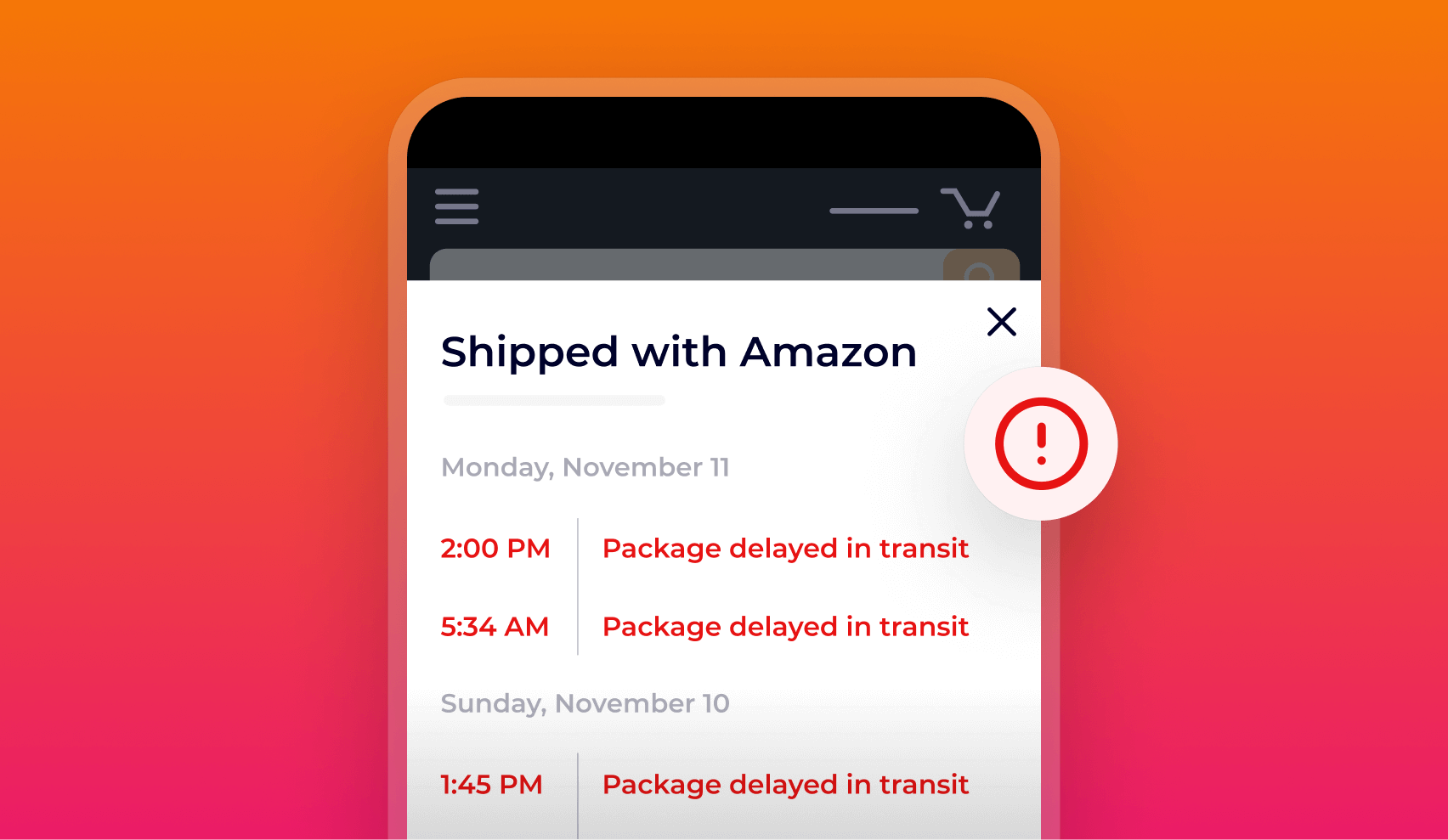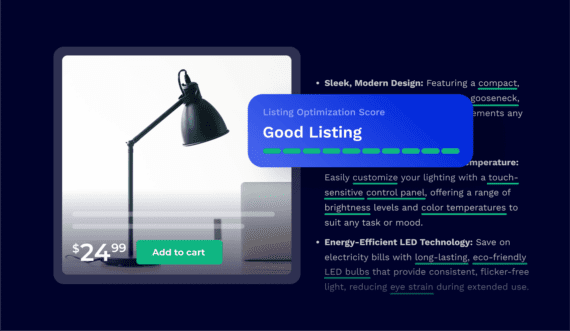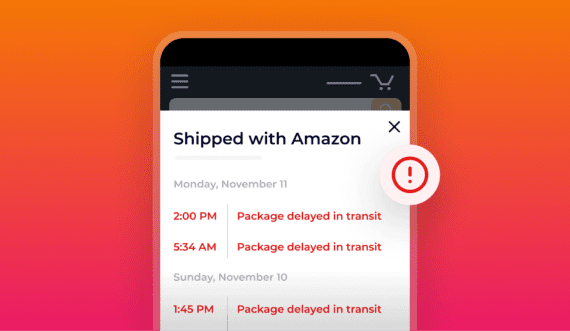Table of Contents
Why do shipping delays happen?
Why shipping delays are a big problem for all Amazon sellers
Shipping delays for FBA sellers vs. FBM sellers: What to consider
The importance of effective communication during shipping delays
How to prevent and minimize shipping and delivery delays
How to streamline your fulfillment process during shipping delays
Content
expand_moreTable of Contents
Why do shipping delays happen?
Why shipping delays are a big problem for all Amazon sellers
Shipping delays for FBA sellers vs. FBM sellers: What to consider
The importance of effective communication during shipping delays
How to prevent and minimize shipping and delivery delays
How to streamline your fulfillment process during shipping delays
Shipping delays are a significant challenge for Amazon sellers, particularly during peak seasons or unforeseen events.
These delays can negatively impact customer satisfaction and lead to bad reviews, lower seller ratings, and even lost sales if your business runs low on inventory.
With increasing competition and high customer expectations, particularly among Amazon Prime members, Amazon sellers must be prepared to handle, communicate, and minimize these shipping delays effectively.
In this guide, we’ll explore why shipping delays happen, the consequences of these delays, and strategies Amazon sellers—whether FBA (Fulfilled by Amazon) or FBM (Fulfilled by Merchant)—can implement to address and avoid disruptions.
Why do shipping delays happen?
Understanding the causes of Amazon shipping delays in your business is the first step in finding solutions so your business doesn’t take a big hit. Here are some of the common reasons behind these delays:
- Supply chain disruptions: Unpredictable global events, geopolitical conflicts, or port congestion can severely disrupt your supply chain, delaying the arrival of products to your or Amazon’s warehouses.
- High demand during peak seasons: Sales events like Prime Day, Black Friday, and the holiday shopping season can lead to high demand, overwhelming Amazon’s fulfillment centers and shipping carriers.
- Carrier delays: External factors, such as weather conditions (snowstorms) or labor shortages, can cause shipping carriers to fall behind schedule, impacting delivery dates and times.
- Inventory shortages: Sellers who fail to replenish their stock adequately may experience stockouts, leading to lost sales as your listings become inactive on Amazon.
- Operational inefficiencies: Bottlenecks within warehouses, delays in order processing, and resource limitations can all lead to fulfillment delays.
The shipping process is complex, so it’s essential to recognize these potential issues regarding various Amazon shipping delays and allow sellers to address and anticipate them, minimizing their impact on business operations. One of the biggest challenges many ecommerce sellers face is insufficient inventory.
Tools such as Jungle Scout’s Inventory Manager help Amazon sellers predict how much stock they’ll need and when to reorder it.
Learn how you can use Jungle Scout to manage your inventory.
Why shipping delays are a big problem for all Amazon sellers
Shipping delays can have a severe impact on Amazon sellers, affecting their product performance, which can negatively impact your product’s Best Seller Rank, reputation, and, more importantly, profitability. Here are the primary ways that delays negatively impact Amazon sellers:
- Negative reviews and poor ratings: Shipping delays often lead to negative customer feedback. When late deliveries occur, customers are more likely to leave poor reviews, which can impact a seller’s reputation and rank in search results.
- Order cancellations: Frustrated customers may cancel delayed orders, leading to a direct loss of sales and potentially higher return costs.
- Reduced seller ratings: Shipping delays and fulfillment issues can lead to a decrease in Amazon’s seller rating metrics. Consistent delays may lead to penalties, lower visibility, and a weakened position in search results.
- Customer expectations: In today’s fast-paced world, customers expect quick and reliable shipping options. Delayed orders can erode trust and make it difficult for sellers to retain loyal customers.
- Decrease in sales: This one is obvious, but if your products are not in stock, you will be missing out on sales and forcing customers to purchase from your competition.
Recent industry statistics highlight that 60% of customers are less likely to purchase from a seller again after experiencing a shipping delay. This makes it imperative for Amazon sellers to address and prevent delays where possible to protect their performance and keep customers satisfied.
Shipping delays for FBA sellers vs. FBM sellers: What to consider
FBA and FBM sellers experience shipping delays differently due to the unique nature of each fulfillment model. Here’s a breakdown of how shipping delays affect each:
| Aspect | FBA Sellers | FBM Sellers |
| Dependency on Amazon’s fulfillment centers | FBA sellers rely on Amazon’s fulfillment centers, making them subject to delays within Amazon’s network. | FBM sellers control their own fulfillment and delivery process, giving them more flexibility but also more responsibility. |
| Shipping control | FBA sellers have limited control over shipping speed and logistics after handing off products to Amazon. | FBM sellers can choose carriers and slow or fast shipping methods, allowing for more customized solutions. |
| Best practices for managing delays | Use tools like Jungle Scout’s Inventory Manager to monitor and restock inventory. Plan for peak seasons by ensuring sufficient stock levels. | Establish reliable relationships with carriers. Use Jungle Scout’s tools to track inventory, automate reordering, and monitor demand trends. |
For FBA and FBM sellers, Jungle Scout’s Inventory Manager is critical for tracking stock levels and restocking before inventory runs low, especially during peak times.
The importance of effective communication during shipping delays
When shipping delays occur, maintaining clear and proactive communication with customers can prevent dissatisfaction and reassure customers that their concerns are being addressed. Here are essential tips for effective communication during delays in a customer’s Amazon package:
- Provide clear reasons for delays: Explaining the cause of a delay—such as weather—adds transparency and can increase customers’ understanding. If you are fulfilling your orders via FBA, Amazon will communicate this to the customer for you.
- Offer alternative solutions: When possible, provide solutions like expedited shipping on a new product, discounts, or partial refunds for the inconvenience. Sellers can issue partial refunds within Seller Central.
- Apologize sincerely: Acknowledge the customer’s frustration and apologize for any inconvenience. Always be sure to remain calm and professional when dealing with frustrated customers.
Clear and timely communication is key to maintaining customer trust and reducing negative feedback during delays. However, if you use FBA to fulfill your Amazon orders, Amazon customer service handles your orders, so a customer will rarely reach out directly to you as the seller regarding a shipping delay.
How to prevent and minimize shipping and delivery delays
Proactively preventing shipping delays or delayed Amazon delivery times can save sellers from headaches, keep customers satisfied, and continue to grow their sales on Amazon. Here are strategies to help Amazon sellers minimize potential delays:
Use inventory management tools
Jungle Scout’s Inventory Manager can predict demand, monitor stock levels, and alert sellers when they should reorder inventory. During peak seasons, it’s especially useful for helping sellers avoid stockouts by providing accurate demand forecasting.
Inventory Manager views the real-time status of your Amazon FBA inventory so you can quickly assess when and how much stock you should reorder. Within the tool, you can also analyze other critical inventory-level metrics, including revenue, cost, profit, average daily sales, and average profit per unit.

Partner with reliable fulfillment providers
If you are an FBM seller, choosing trustworthy third-party logistics (3PL) providers can help sellers meet demand efficiently. Partnering with a reputable 3PL can reduce the likelihood of delays due to fulfillment issues. Jungle Scout recommends evaluating 3PL providers with a proven track record of timely delivery and accurate tracking information, especially during high-demand periods.
Of course, the best way to fulfill products on Amazon, in our opinion, is by leveraging Amazon’s FBA program. Amazon handles the storing, picking, packing, and shipping of your products. Plus, your product will have the Prime membership badge (unless you use Seller-Fulfilled Prime.)
Plan for seasonal demand
Analyzing historical data and anticipating high-demand seasons, such as holidays or Prime Day, enables sellers to adjust inventory levels in advance. This proactive approach can prevent delays caused by inventory shortages or operational bottlenecks.
Sellers can view historical data of their products by using Jungle Scout’s Product Tracker tool
Distribute inventory across warehouses
If possible, FBM sellers should strategically place inventory in multiple fulfillment centers across different regions. This can reduce shipping times and mitigate the impact of regional disruptions. Many 3PL services have multiple fulfillment centers to split inventory.
Sellers who distribute inventory can avoid placing all their stock in one location, which can be advantageous during unforeseen events or regional issues.
If you are using FBA, Amazon will automatically move your inventory to different fulfillment centers across the country to ensure your products will be delivered in a specific timeframe, no matter where your customers are.
Automate reordering processes
Automating the reordering process helps prevent stockouts and ensures that products are available for shipment. Using Jungle Scout’s Inventory Manager tool allows sellers to keep up with demand effortlessly, ensuring that they have the right amount of stock available when they need it.
Maintain strong relationships with your suppliers to ensure they can deliver your products on time when you need to reorder inventory.
How to streamline your fulfillment process during shipping delays
Once shipping delays have occurred, it’s essential to take swift action to minimize further customer impact. Here’s how:
Set up a contingency plan for delays
Having a contingency plan that includes alternative carriers and backup fulfillment providers can help sellers handle delays effectively. For example, sellers can arrange agreements with alternative carriers in advance to quickly shift operations when necessary.
Automate shipping updates for faster communication
Automating customer notifications for order updates can reduce manual work and ensure customers receive real-time updates.
How Jungle Scout Can Help Amazon Sellers Facing Shipping Delays
Jungle Scout’s suite of tools is designed to help Amazon sellers manage and prevent shipping delays. Key features include:
- Inventory Manager: This tool provides real-time insights into stock levels, predicts demand, and tells you when to reorder, helping sellers avoid stockouts and meet demand. Inventory Managers can also help minimize FBA fees and shipping fees.
- Product Tracker: Monitors inventory flow and provides insights into product performance, helping sellers spot potential bottlenecks or delays early on. By viewing your sales trends in Product Tracker, you can get a better idea of how much inventory you expect to sell.
By offering solutions that streamline fulfillment processes and enhance inventory management, Jungle Scout helps sellers proactively address and manage shipping challenges.
Stay ahead of shipping delays using Jungle Scout’s insights
Shipping delays are a complex challenge for Amazon sellers, but they can be effectively managed by implementing proactive measures.
From using data-driven tools to adopting clear communication strategies, Amazon sellers can minimize the impact of delays and maintain strong customer relationships.
Jungle Scout’s tools provide sellers with the insights and automation capabilities they need to stay on top of inventory, demand forecasting, and customer communication, making it easier to prevent and address delays.
Ready to streamline your Amazon business and avoid shipping delays?
Brian Connolly is an Amazon seller, ecommerce expert, and writer for Jungle Scout. He lives in the New Jersey Shore area with his wife and cat. When he isn’t writing advice online for aspiring and experienced Amazon sellers for Jungle Scout, he spends his free time boating, fishing, and selling boating-themed items on his Amazon business.










